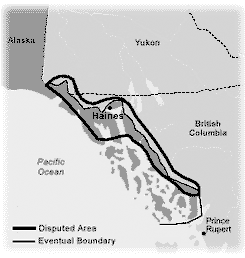The boundary separating Canada from the Alaskan panhandle was poorly defined before the turn of the 20th century, but clarity was not deemed important. It seemed to make little difference since the border area was rugged wilderness. That casual attitude evaporated after gold was discovered in the Klondike in 1896 and the panhandle offered a ready means of entry to the gold fields.
 American and British negotiators (Britain then represented Canada in foreign affairs) failed to reach agreement in 1898. Canada pressed its position vigorously, arguing that its territory breached the panhandle and reached the Pacific Ocean; the United States stoutly rejected this view. Talks dragged on until 1902, when Britain proposed arbitration. A reluctant President Roosevelt eventually agreed.
Each side nominated three commissioners; a majority vote was necessary to decide matters. The Americans appointed representatives loyal to their government’s position, but the British selected two Canadians and an English jurist. Matters were decided in favor of the American claim by a vote of four to two.
It is not known whether the Englishman was influenced by his government. It was clear, however, that Britain was more concerned about maintaining positive relations with the United States than in placating the people of western Canada. Settlement of the Alaskan boundary dispute was a major step forward in Anglo-American cooperation.
American and British negotiators (Britain then represented Canada in foreign affairs) failed to reach agreement in 1898. Canada pressed its position vigorously, arguing that its territory breached the panhandle and reached the Pacific Ocean; the United States stoutly rejected this view. Talks dragged on until 1902, when Britain proposed arbitration. A reluctant President Roosevelt eventually agreed.
Each side nominated three commissioners; a majority vote was necessary to decide matters. The Americans appointed representatives loyal to their government’s position, but the British selected two Canadians and an English jurist. Matters were decided in favor of the American claim by a vote of four to two.
It is not known whether the Englishman was influenced by his government. It was clear, however, that Britain was more concerned about maintaining positive relations with the United States than in placating the people of western Canada. Settlement of the Alaskan boundary dispute was a major step forward in Anglo-American cooperation.